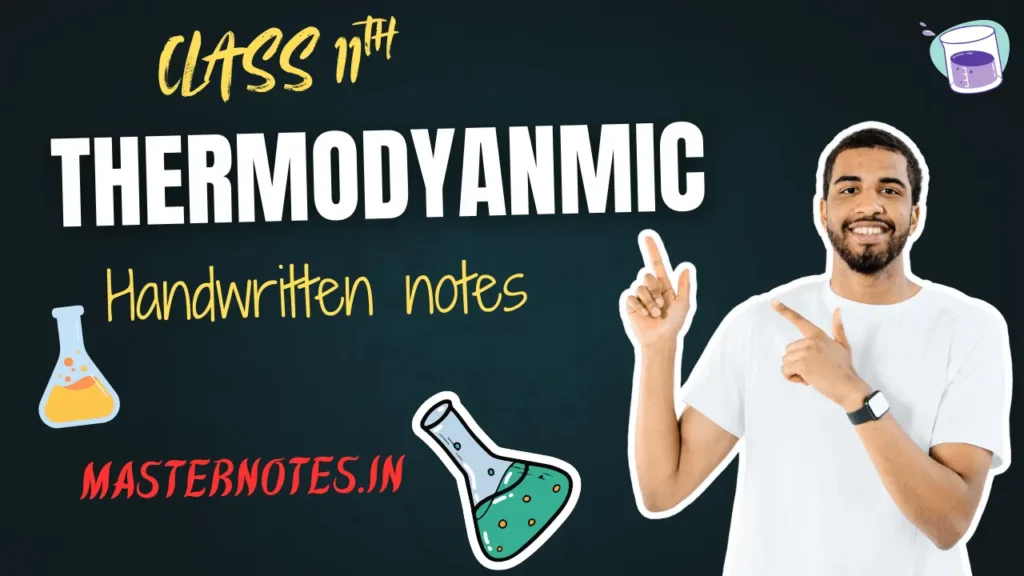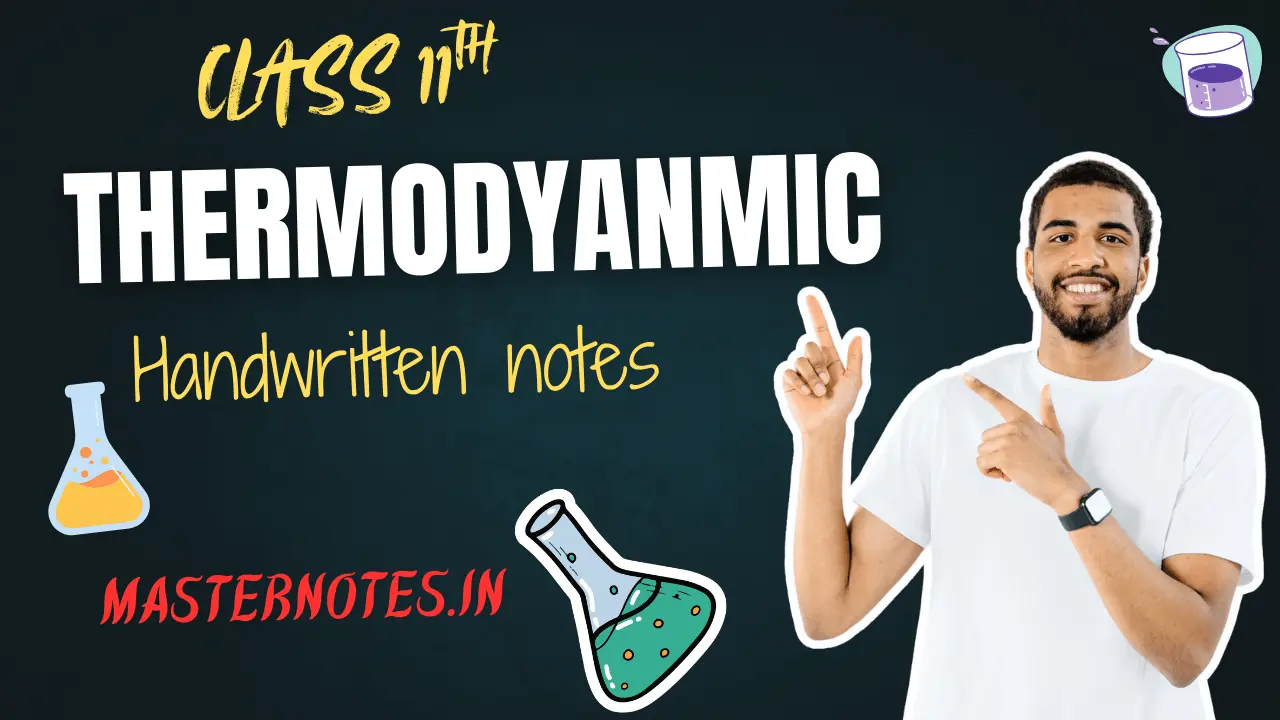In this chapter we are discussed about the Thermodynamics class 11th Physics notes From physics 2024-25.Here we are providing the complete & detail notes from the following chapter. This website is specially for students to help in achieving their goal and marks. we are providing a complete solution of for class 9th to 12th of all subjects. For more content explore the website ” Masternotes.in” if you like this content then please share and if any doubt then write a comment. if anyone want to publish their content on this website, contact us through comment. we will contact you as soon as possible. Thanks for explore this website.
Introduction to Thermodynamics
Thermodynamics (Thermodynamics class 11th Physics notes) is the branch of physics which deals with heat, work, and with energy.
It explains us how energy moves between the systems and how it affects matter.
In the simple words, thermodynamics is about to how things get hot, cool down, and also how energy changes from one form to another form.
In Class 11, you will learn the basic ideas that control the energy changes.
You’ll see how gases behave and also what happened during different processes like heating and compression.
Master Notes will make sure that you understand each part without getting confused.
Table of Contents
Syllabus of Thermodynamics Class 11th Physics 2024-25
- Thermal Equilibrium and Zeroth Law of Thermodynamics
- Concept of Heat, Work and Internal Energy
- First Law of Thermodynamics
- Thermodynamic Processes
– Isothermal, Adiabatic, Reversible, Irreversible and Cyclic
- Second Law of Thermodynamics
Thermal Equilibrium and Zeroth Law of Thermodynamics
When two objects are in contact and there is no heat flows between them, they are said to be in thermal equilibrium.
It means that both have the same temperature.

Zeroth Law of Thermodynamics:
- It says that if object A is in thermal equilibrium with the object B, and object B is in thermal equilibrium with the object C, then object A and object C are both also in thermal equilibrium with each other.
This law is most important because it helps us to define what temperature actually is!
Without the Zeroth law, we did not properly use thermometers or measure the temperatures.
Thermodynamics class 11th Physics notes
Heat, Work, and Internal Energy
- Heat: Heat is the energy transferred between the two systems because of the temperature difference.
It always flows from a hot object to a cool object.
- Work: In thermodynamics, work is done when a system is expand or contracts against an external pressure.
For example, when the gas expands inside a piston and pushes it, it is doing work.
- Internal Energy : It is the total energy stored inside a system, which include both the kinetic energy and potential energy . thermodynamics class 11 Physics notes for neet pdf
Heat and work both are two ways by which internal energy can change.
If we heat a system or we do work on it, its internal energy goes up.
First Law of Thermodynamics
Statement:
“The change in internal energy of the system is equal to the heat which is added to the system minus the work done by the system.”
Mathematically we see,
ΔU=Q−W\Delta U = Q – WΔU=Q−W
Where:
- ΔU = Change in the internal energy
- Q= Heat supplied to a system
- W= Work done by a system
This is basically the law of conservation of energy.
Energy could not be created or destroyed, it can only change one form into another form.
If we give heat to a system, it either increases the system’s energy or gets used up in the doing work.
thermodynamics class 11th Physics notes,thermodynamics class 11th Physics notes pdf ,thermodynamics class 11 Physics notes for jee pdf ,thermodynamics class 11 Physics notes for neet pdf ,thermodynamics class 11 Physics notes self study
Thermodynamic Processes
There are different types of processes which depends on how heat, work, and energy changes. Let’s see these one by one:
- Isothermal Process:
- Temperature remains constant throughout this process.
- Since temperature even doesn’t change, internal energy also remains the same.
- Example: Slow compression or the expansion of gas in the thermal bath.
- Adiabatic Process: thermodynamics class 11 Physics notes for jee pdf
- No heat is being exchanged with the surroundings (Q = 0).
- Any change in the energy happens only because of the work done.
- Example: Rapid compression of the air in a bicycle pump.
- Reversible Process:
- The process that happens very slowly and can be reversed by the changing conditions slightly.
- Both system and surroundings can be restored back without any changes.
- Ideal case; it is not possible in real life!
- Irreversible Process:
- The real-world process that cannot be reversed completely.
- There is always some of the loss of energy, usually in the form of the heat or the friction.
- Example: Natural processes like mixing of hot and cold water.
- Cyclic Process:
- When a system goes through changes but finally returns to its original state.
- In the complete cycle, net change in the internal energy is being zero.
- Example: A heat engine is working through continuous cycles.
Second Law of Thermodynamics
While the First Law talks about the energy conservation, it did not tell us whether a process will happen or not happen.
That’s where the Second Law comes in.
Main Points of the Second Law: thermodynamics class 11 Physics notes for jee pdf
- Heat has always flows naturally from a hotter object to a colder object, never the reverse of it.
- No heat engine can be convert all of the absorbed heat into the work without some loss.
- There is always some of the wasted energy in any real process (usually as the heat).

Kelvin-Planck Statement:
“It is impossible to construct a device which operates in the cycle and produces no effect other than the conversion of the heat into the work.”
Clausius Statement:
“It is impossible to make the heat flow from a cooler body to a hotter body without the external work.”
Basically, Second Law explains why perpetual motion machines are impossible and why everything tends toward disorder (entropy).
Thermodynamics class 11 Physics notes self study
About the Author
Name : Vijeta
Teacher Name : Dinesh Kumar
| S.NO | Name of Chapter | View |
| 1. | Physical World | Click |
| 2. | Units and Measurements | Click |
| 3. | Motion in a Straight Line | Click |
| 4. | Motion in a Plane | Click |
| 5. | Laws of Motion | Click |
| 6. | Work, Energy and Power | Click |
| 7. | System of Particles and Rotational Motion | Click |
| 8. | Gravitation | Click |
| 9. | Mechanical Properties of Solids | Click |
| 10. | Mechanical Properties of Fluids | Click |
| 11. | Thermal Properties of Matter | Click |
| 12. | Thermodynamics | Click |
| 13. | Kinetic Theory | Click |
| 14. | Oscillations | Click |
| 15. | Waves | Click |
| THANKU |
Comprehensive Coverage: These notes provide an in-depth analysis of each topic, covering all essential concepts in coordination compounds.
Easy-to-Understand Language: The notes are written in a clear and concise manner, making complex ideas easier to grasp.
Illustrative Diagrams: Visual aids and diagrams accompany the explanations, facilitating better understanding and retention.
Exam-Oriented: Designed with Class 12 board exams in mind, these notes are tailored to help you excel in your examinations.
Whether you are a student aiming for top grades or someone curious about the fascinating world of coordination compounds, these master notes are your ultimate resource. Enhance your knowledge, strengthen your concepts, and unlock the secrets of coordination compounds with this all-encompassing study material. Happy learning! Youtube







